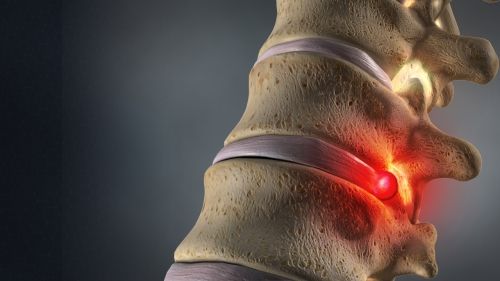What are my therapy options for a herniated disc?

What is a herniated disc or slipped disc?
The 26 vertebrae that make up your spine are cushioned by soft, rubbery discs. They allow the spine to bend and flex while also acting as shock absorbers. Discs can experience wear and tear over time and they can be aggravated by certain activities or conditions like improper lifting, excessive body weight, smoking, sudden pressure, and repeated strenuous activities. When a cushion ruptures, you now have a condition known as a herniated disc or slipped disc.
The common symptoms of a herniated disc? It’s the lower back pain or neck pain you may be experiencing right now. The protruding disc can also inflame nerve roots and lead to sciatic nerve pain. Not treating a herniated disc can lead to permanent nerve damage that causes an array of potential complications in the future, such as losing sensation in the inner thighs and legs.
Therapies for a herniated disc or slipped disc
Our experts at Baldwin Bone and Joint recommend several types of therapies for a herniated disc, depending on the situation.
Medications and Injections – Your doctor may recommend over-the-counter pain medication like Tylenol or Advil for mild to moderate discomfort. If you’re suffering from more severe pain, he or she may prescribe a narcotic or anticonvulsant, to be used for a limited duration of time. Other recommended treatments might include a muscle relaxer if you are experiencing muscle spasms.
Injections – An epidural steroid injection is a quick and simple procedure that can quickly relieve pain. For the procedure, the irritated spinal nerve (caused by the protrusion of the herniated disc) is bathed in steroids, a powerful anti-inflammation medicine.
Core Strengthening – Strengthening your core is critical to keeping your spine healthy. It means relieving some of the burden your back muscles have in supporting your spine, which can result in less back pain. That could mean heading to your local Pilates or yoga studio and practicing your favorite poses. For more personal support from a trained specialist, you can participate in a lumbar stabilization program supervised by a physical therapist.
Physical Therapy – Going to physical therapy is an investment in the optimal functioning of your body. When your muscles work together effectively, they pave the way to a healthier spine that will reduce the chances of future injuries. Physical therapists can help improve your strength, flexibility, and motion by teaching you proven exercises and stretches, using proper techniques that will provide the safest possible training program. They can monitor and holistically evaluate your progress in order to determine the best combination of exercises that will help you reach optimal spine health.
To request an appointment with the team at Baldwin Bone and Joint, please click here.